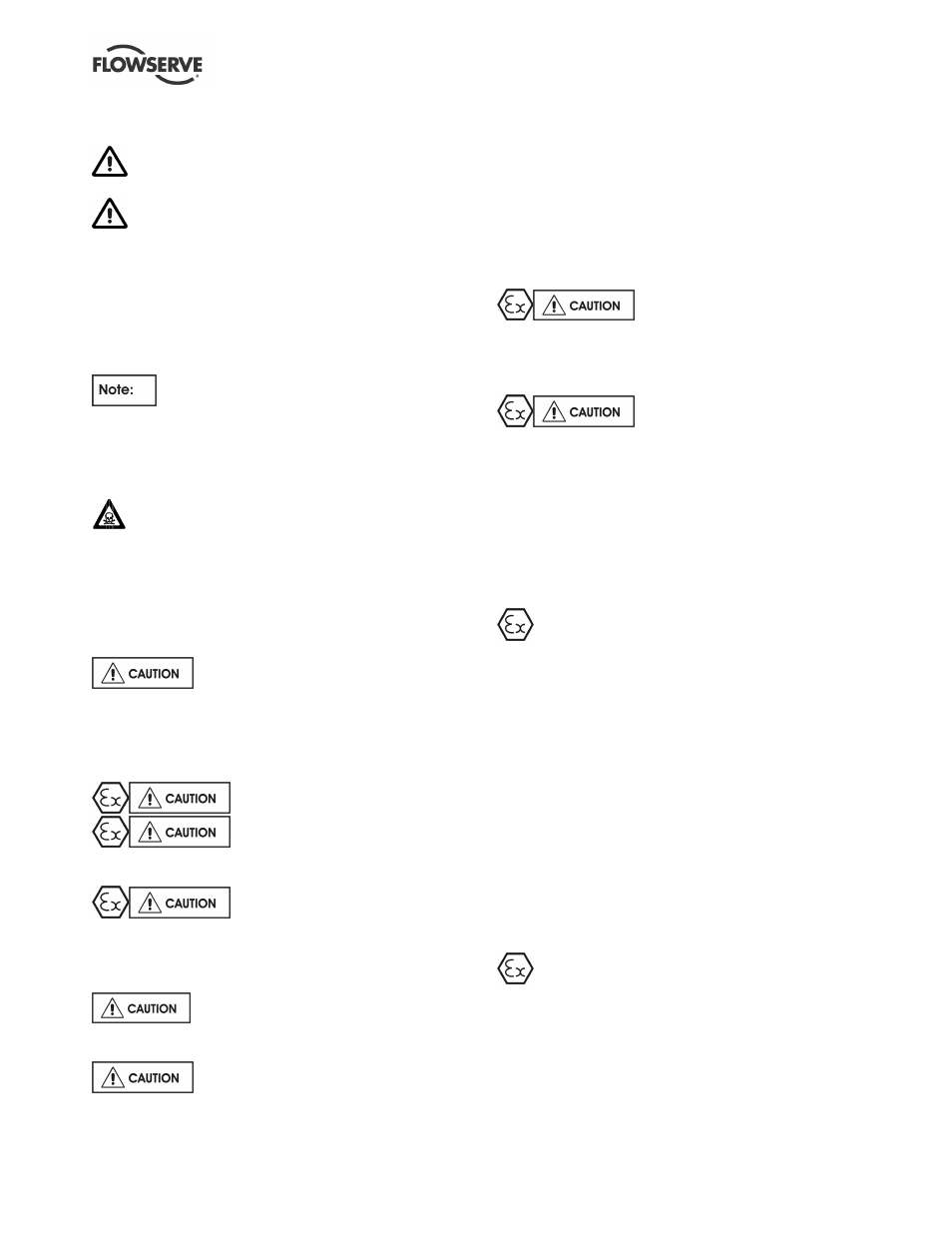Flowserve CPXS User Manual
Page 6

CPXS, CPXNS and CPXPS USER INSTRUCTIONS ENGLISH 71569250 07-11
Page 6 of 48
flowserve.com
in damage or breakage of components and should be
avoided.
NEVER APPLY HEAT TO REMOVE IMPELLER
Trapped lubricant or vapour could cause an explosion.
HOT (and cold) PARTS
If hot or freezing components or auxiliary heating
supplies can present a danger to operators and
persons entering the immediate area action must be
taken to avoid accidental contact. If complete
protection is not possible, the machine access must
be limited to maintenance staff only, with clear visual
warnings and indicators to those entering the
immediate area.
bearing housings must not be insulated and
drive motors and bearings may be hot.
If the temperature is greater than 80 ºC (175ºF) or
below -5 ºC (23 ºF) in a restricted zone, or exceeds
local regulations, action as above shall be taken.
HAZARDOUS LIQUIDS
When the pump is handling hazardous liquids care
must be taken to avoid exposure to the liquid by
appropriate siting of the pump, limiting personnel
access and by operator training. If the liquid is
flammable and or explosive, strict safety procedures
must be applied.
PREVENT EXCESSIVE EXTERNAL
PIPE LOAD
Do not use pump as a support for piping. Do not mount
expansion joints, unless allowed by Flowserve in
writing, so that their force, due to internal pressure, acts
on the pump flange.
NEVER RUN THE PUMP DRY
ENSURE CORRECT
LUBRICATION (See section 5, Commissioning,
startup, operation and shutdown.)
ONLY CHECK DIRECTION OF
MOTOR ROTATION WITH COUPLING SPACER
PIECE REMOVED
Starting in reverse direction of rotation will damage the
pump.
NEVER EXCEED THE MAXIMUM
DESIGN PRESSURE (MDP) AT THE WORKING
TEMPERATURE OF THE PUMP NAMEPLATE
START THE PUMP WITH OUTLET
VALVE PART OPENED
(Unless otherwise instructed at a specific point in the
User Instructions.)
This is recommended to minimize the risk of
overloading and damaging the pump or motor at full or
zero flow. Pumps may be started with the valve further
open only on installations where this situation cannot
occur. The pump outlet control valve may need to be
adjusted to comply with the duty following the run-up
process. (See section 5, Commissioning start-up,
operation and shutdown.)
INLET VALVES TO BE FULLY
OPEN WHEN PUMP IS RUNNING
Running the pump at zero flow or below the
recommended minimum flow continuously will cause
damage to the pump.
DO NOT RUN THE PUMP AT
ABNORMALLY HIGH OR LOW FLOW RATES
Operating at a flow rate higher than normal or at a flow
rate with no back pressure on the pump may overload
the motor and cause cavitation. Low flow rates may
cause a reduction in pump/bearing life, overheating of
the pump, instability and cavitation/vibration.
1.6.4
Products used in potentially explosive
atmospheres
Measures are required to:
•
Avoid excess temperature
•
Prevent build up of explosive mixtures
•
Prevent the generation of sparks
•
Prevent leakages
•
Maintain the pump to avoid hazard
The following instructions for pumps and pump units
when installed in potentially explosive atmospheres
must be followed to help ensure explosion protection.
For ATEX, both electrical and non-electrical equipment
must meet the requirements of European Directive
94/9/EC. Always observe the regional legal Ex
requirements eg Ex electrical items outside the EU
may be required certified to other than ATEX eg
IECEx, UL.
1.6.4.1
Scope of compliance
Use equipment only in the zone for which it is
appropriate. Always check that the driver, drive
coupling assembly, seal and pump equipment are
suitably rated and/or certified for the classification of
the specific atmosphere in which they are to be
installed.